Semi-Log Graph
Sunday, March 12, 2017
Semi-Log Graphs
Recently I was introduced to a concept of graphing called semi-log graphing. When most people use graphs, they use linear scales for both the x and y axes, but semi-log graphs use a linear scale for the x axis and a logarithmic scale for the y axis, hence semi-log. How this logarithmic scale works is it goes up from numbers one-ten, then continues as such but with the numbers ten-twenty. Essentially, you ad a zero after the numbers of the scale every ten numbers. This logarithmic scale is very useful for looking at certain functions, like exponential functions. Below are graphs of the functions f(x) = 2^x and g(x) = 3^x on both a semi-log graph and standard graph. You can see the values are much clearer on a semi-log graph, but it can be difficult to recognize the function without understanding the semi-log format.
Wednesday, March 1, 2017
Exponential Functions
Exponential functions are an interesting concept that can be used to describe extreme growth of things and numbers. Whet graphing an exponential function it loos like this: y = n ^ x. This means that every y value is a number and the x value as its exponent. Imagine this; on the internet, somebody posts some information. In the next hour (the internet is very slow today) three people see this information, and in the next hour they each share it with three people, and so on. The numbers of people who see the information greatly increases each hour. By hour fifteen, over ten-million people have seen the information. Now imagine if ten people shared this information every hour (the internet is slightly less broken). graph of this information on very low levels can be seen below. If everyone could and wanted too, all the people in the world could see the information in less than a day with both these functions. And remember, this is some people sharing every hour, when really information can now be shared every couple seconds. Imagine what would happen if 100 people shared every fifteen seconds? No, the internet needs longer to repair, so thirty seconds. It would take five minutes for more people than those that exist to see the information.
Here you see both these functions, and the points that correspond to the natural numbers that allow visibility. The black line (No, not the y -axis) represents y = 10^ x, and the red line represents y = 3 ^ x. (1, 10) and (2, 100) are the points that represent the black line function. Even at this beginning scale, you can see how quickly the function rises.
Friday, February 17, 2017
Pascal's Triangle
Pascal's triangle is a very interesting piece of mathematics named for French mathematician Blaise Pascal, although this triangle was being studied centuries before him in China, India, Persia, Germany, and Italy. The is formed as such: Start with one at the top, then place the numbers below in a triangle formation, and add numbers as they combine, so you place two ones underneath, then place two ones on the sides again, but this time in the center they will add up to two. This pattern continues all the way down the triangle, which is infinite.
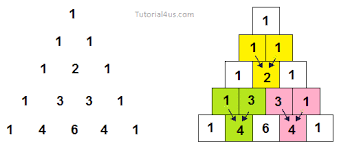
There are many patterns hidden within this triangle. For instance, if you write out the sums of the numbers in each row, you find the numbers double, starting with one, then two, then four, then eight, and so on. Also, if you look at the numbers formed by each row, you find that besides the top each are a multiple of eleven, This starts with 11(11 * 1), then 121(11*11), then 1331(11*121). This works all the way down the triangle, even with a row like 1, 5, 10, 10, 5, 1. Here, you carry over, resulting in the number 161,051(11 * 14641). This pattern is best seen with powers of 11, starting with 110
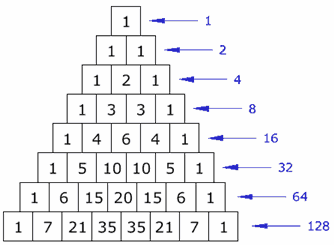
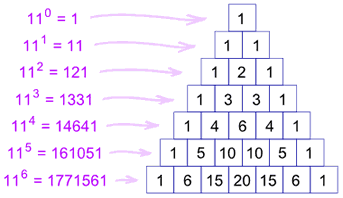
Another interesting thing is if you loom at the diagonals of this triangle. the sums of the numbers in the diagonals will give you the Fibonacci sequence. The diagonals in sequence also have things of interest, the first being ones, the second being counting numbers, the third being triangular numbers, and the fourth being square numbers.

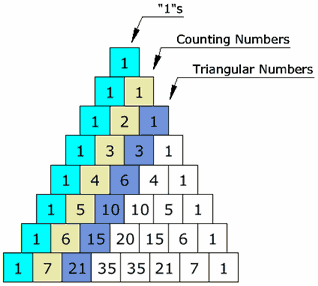
Another strange and interesting thing one can see in this triangle are the Catalan Numbers. The Catalan Numbers are taking shapes and finding out how many triangles it can be divided into by connecting vertices. In Pascal's triangle these numbers are found by taking the even numbers in the center of almost every other row and subtracting the number adjacent to it.

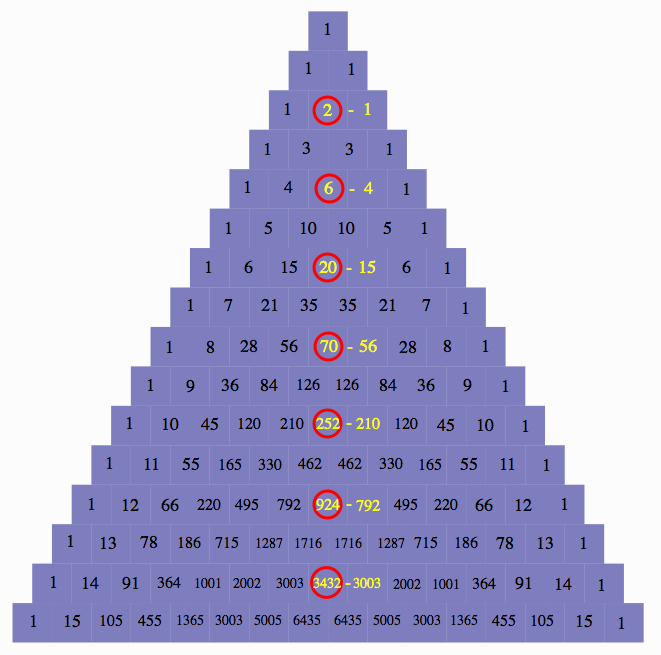
Finally (but not really) If you highlight every even number in Pascal's Triangle, you get a fractal that is essentially Sierpinski's Triangle.


Sources:
There are many patterns hidden within this triangle. For instance, if you write out the sums of the numbers in each row, you find the numbers double, starting with one, then two, then four, then eight, and so on. Also, if you look at the numbers formed by each row, you find that besides the top each are a multiple of eleven, This starts with 11(11 * 1), then 121(11*11), then 1331(11*121). This works all the way down the triangle, even with a row like 1, 5, 10, 10, 5, 1. Here, you carry over, resulting in the number 161,051(11 * 14641). This pattern is best seen with powers of 11, starting with 110


Another interesting thing is if you loom at the diagonals of this triangle. the sums of the numbers in the diagonals will give you the Fibonacci sequence. The diagonals in sequence also have things of interest, the first being ones, the second being counting numbers, the third being triangular numbers, and the fourth being square numbers.


Another strange and interesting thing one can see in this triangle are the Catalan Numbers. The Catalan Numbers are taking shapes and finding out how many triangles it can be divided into by connecting vertices. In Pascal's triangle these numbers are found by taking the even numbers in the center of almost every other row and subtracting the number adjacent to it.


Finally (but not really) If you highlight every even number in Pascal's Triangle, you get a fractal that is essentially Sierpinski's Triangle.

Sources:
Thursday, January 5, 2017
Math Jokes...Yeah
I post these nine math jokes because I am forced to. I am one of those people, but not in this particular situation. As I write this blog, I am laughing and crying at the same time. I am laughing because of the the math jokes, and I am crying because I'm laughing at math jokes
Hey, wanna hear a funny Joke? The grade I got on my math final.


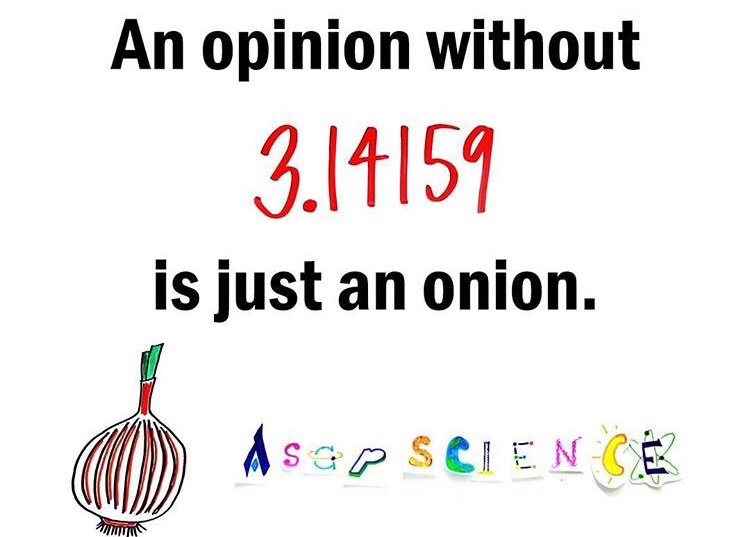
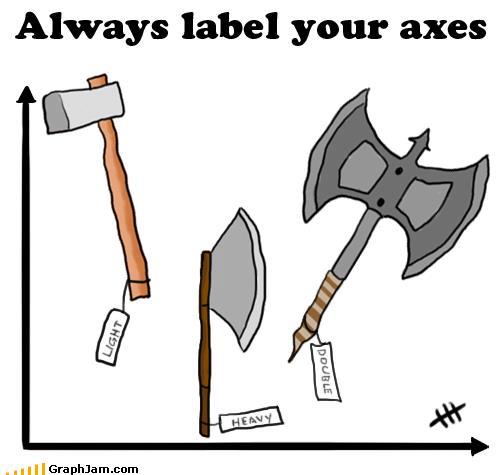



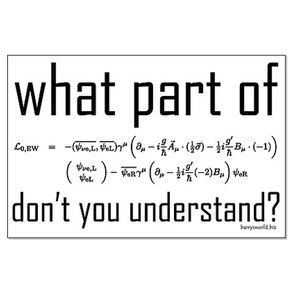

Sources:
https://www.pinterest.com/cjlives/math-jokes/
http://imgur.com/gallery/YN1s5
http://meganpanagia.weebly.com/math-jokes.html
https://www.tes.com/lessons/JF047dHDorVKrw/math-funnies
https://www.pinterest.com/MissJacSimons/math-jokes/
https://www.pinterest.com/gaberobare/math/
https://www.pinterest.com/logarhythm12/math-jokes/
https://www.cazoommaths.com/maths-jokes/
Hey, wanna hear a funny Joke? The grade I got on my math final.









Sources:
https://www.pinterest.com/cjlives/math-jokes/
http://imgur.com/gallery/YN1s5
http://meganpanagia.weebly.com/math-jokes.html
https://www.tes.com/lessons/JF047dHDorVKrw/math-funnies
https://www.pinterest.com/MissJacSimons/math-jokes/
https://www.pinterest.com/gaberobare/math/
https://www.pinterest.com/logarhythm12/math-jokes/
https://www.cazoommaths.com/maths-jokes/
Subscribe to:
Posts (Atom)



